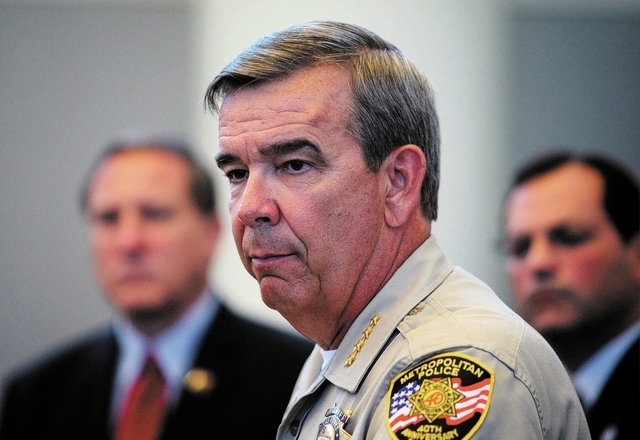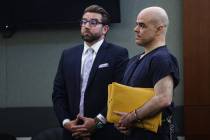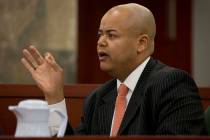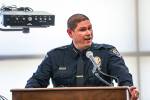Sheriff argues more crime justifies ‘More Cops’
After years of decline, crime rates in Las Vegas inched up slightly in 2012.
It’s too soon to tell if that increase is the start of a trend, but the uptick gives political ammunition to Clark County Sheriff Doug Gillespie, who is trying to convince county commissioners to raise the sales tax rate to pay for more cops on the street.
Commissioners on Tuesday face a choice between dueling sales tax proposals, both of which would raise money to increase the ranks of police in all local departments.
No one disputes that Clark County’s police ranks are a little thinner than they were before the recession hit. Gillespie’s Metropolitan Police Department, the largest recipient of any tax hike, is down from a peak of 2,741 cops in 2010, to 2,480 officers this year. That’s a nearly 10 percent drop.
The ratio of budgeted officer positions for every 1,000 residents dropped from 2.16 in 2009 to 1.85 in 2012.
Beyond that, county and local leaders must weigh a witch’s brew of disputed dollar figures, crime statistics and head counts, not to mention changes in the Las Vegas area’s population over the years.
Commissioners have options. They could do nothing, raise the sales tax rate by 0.15 percentage points, or raise it by only half that rate.
Commissioner Tom Collins is pushing a proposal for the full 0.15 percentage-point increase the Legislature allowed.
Commissioner Susan Brager’s proposal seeks only half the allowed increase, a 0.075 percentage-point hike. Her proposal would require the Police Department to tap into its reserve fueled by the initial More Cops sales tax, which holds about $124 million.
The sales tax rate in Clark County is currently 8.1 percent.
Gillespie had asked the Legislature to give the county authority for a 0.25 percentage-point increase for officers. Lawmakers instead allowed an increase of up to just 0.15 percentage points, leaving the final decision to county commissioners.
If approved, revenues from any increase would go to police in Las Vegas, North Las Vegas, Henderson, Mesquite and Boulder City.
County residents in 2004 had approved an advisory vote of 0.5 percentage points, or a half-cent, increase in the sales tax rate. Lawmakers in 2005 allowed the county to enact just half that amount, 0.25 percentage points.
FIGHTING CRIME
The crime rate in Las Vegas has been falling in recent years, except for 2012. Property crimes hit a low of 2,840 incidents per 100,000 residents in 2011, down 41 percent from 4,838 incidents in 2005, according to FBI crime statistics. In 2012, the rate of property crime crept up 10 percent, to 3,138 incidents for every 100,000 residents, according to crime data. Property crimes include burglary, thefts and arson.
The rate of violent crimes, which encompasses homicides, robberies, rapes, and aggravated assaults, hasn’t changed as much.
“I think what you see pretty clearly here is when the number of officers were increased, you saw the crime rate going down,” Gillespie said.
At the same time, police call volume has increased in the past two years. Police received 1.04 million calls from the public in 2012, a 19 percent increase from 2010.
The increase in call volume means police had less time to initiate their own “calls” while looking for criminal activity. In 2010, officers initiated 773,639 calls. In 2012, that figure dropped by 10 percent, to 695,513 calls.
“I think the statistics bear it out that police officers in uniform, in black-and-whites that are not call-driven, meaning they’re not going from call to call, meaning there is discretionary time, there is downtime and they use that time proactively — car stops, people stops, business interactions, things of that nature — it positively impacts your crime rate,” Gillespie said.
As Las Vegas police ranks have thinned, officer response times to calls have increased. For the highest-priority — typically a violent crime in progress — it took an average of 8.38 minutes for an officer to arrive on the scene in 2010. In 2012, the average time had increased to 9.13 minutes, or nearly 9 percent longer.
But for a less pressing matter without immediate danger, the wait can be much longer.
For example, on Thursday night dozens of unanswered calls piled up as officers handled traffic control for nearly two hours at an unexpected Transport Workers Union demonstration.
Lower priority calls — burglary or vandalism, not in progress — can sit for hours before an officer responds.
“Usually, we have about 17 calls holding,” said Sgt. Dan Newberry, an 18-year veteran of the force.
Newberry is assigned to the department’s Enterprise Area Command, a swath of southwest Las Vegas west of Interstate 15 and south of West Charleston Boulevard.
Gillespie also says having more officers allows for proactive traffic enforcement that encourages safe driving and reduces fatal accidents.
Clark County had 109 traffic fatalities in 2012, the first year since 2008 that the count has reached triple-digits. Fatalities ranged from 72 to 86 between 2009 and 2011. Historically, fatalities have been higher, peaking at 184 in 2005, according to police data.
Collins is eyeing more than crime rates, asking: “How many jobs would be lost if tourism dropped because people thought Las Vegas wasn’t a safe place or Clark County wasn’t a place to visit?”
COUNTING COPS
While there are 261 fewer Las Vegas police officers since 2010, that number alone doesn’t tell the full story.
In 2008, as the Great Recession roared to life, 2,498 Las Vegas officers were on the payroll. Five years later, in July, the department had 2,480 officers, a reduction of just 18 cops, or less than 1 percent.
By comparison, the department has weathered the recession better than other government agencies. Clark County’s workforce is 23 percent smaller than it was in 2008, according to a legislative report.
“Our workload hasn’t gone down,” Gillespie said. “You just can’t, I don’t think, compare reductions at Metro to what reductions have been to other areas of government.”
Gillespie stands by his method of comparing officer staffing to 2010 levels rather than 2008. In 2008, the department was still hiring and training officers with the money from the first sales tax increase, which started in 2005. The staffing levels contrasting 2010 and 2013 show how many officers the department has trimmed, he said.
Despite the catchy “More Cops” moniker, the sales tax wouldn’t do much to increase the number of officers in Las Vegas.
After lawmakers this year authorized the sales tax increase, Gillespie told commissioners it would allow him to keep about 250 officers on the job and hire another 100. But with attrition and retirements, the force wouldn’t actually get any bigger.
That’s one reason why Commission Chairman Steve Sisolak doesn’t support raising the sales tax.
“This is not for more cops,” he said. “This is to fill his budget hole. It’s the same number of cops. I don’t think that was the intent of voters.”
But Collins points to the need for public safety, noting it benefits Las Vegas police and other departments in the county.
“There’s probably going to be two chances to vote next week, and if nothing passes, we’ll be laying off cops,” he said. “Do you want more public safety?”
He also notes that the 0.15 percent increase the Legislature authorized is already reduced from the quarter-cent increase proposed.
“Anything less than 0.15 cents is not more cops,” Collins said.
DOLLARS AND DIFFERENCES
Money that taxpayers already have forked over to the public coffers is also part of the debate.
The More Cops sales tax increase of 2005 has paid for about 520 Las Vegas police officers. At the same time, the unspent money from that tax has grown to about $124 million.
In response, some county commissioners want Gillespie to tap that account to help cover his budget shortfall, which the sheriff has pegged at $30 million.
Brager’s pared-down sales tax proposal would require the sheriff to take $15 million from the More Cops account to cover half his budget shortfall. By doing so, the smaller tax rate would pay for about 125 officers.
She wants Gillespie to tap into the fund because it is estimated the account will still have $26 million left in it when the tax sunsets in 2025.
Gillespie hasn’t publicly supported or opposed Brager’s proposal, but he has been reluctant to tap the More Cops account. Doing so, he contends, isn’t a long-term solution and would eventually create two deficits instead of one.
Sisolak said pursuing a tax increase isn’t the right approach when the department is sitting on a sizable reserve.
There also are differences of opinion about the $30 million shortfall figure. The sheriff says he will be $30 million short without a sales tax increase. County officials found the Police Department started the fiscal year in July with an extra $9 million, which raised questions about the accuracy of the $30 million figure. The sheriff has attributed the extra $9 million to various one-time sources of money, including an arbitration settlement with the civilian employees union and an insurance payment for a wrecked helicopter.
OTHER DEPARTMENTS
For the North Las Vegas Police Department, the larger of the two sales tax bumps would mean about 27 more officers; the smaller boost would mean about 13 more, Sgt. Tim Bedwell said.
“At this point, we’re in a wait-and-see mode,” Bedwell said.
On the high end, the sales tax increase still wouldn’t restore what the department has lost since 2008. The city’s force has decreased from 334 officers in 2008 to 270 officers. That’s a loss of 64 officers, or nearly 20 percent.
For the Henderson Police Department, the range is 38 officers or 19, spokesman Keith Paul said. The department now has 327 officers.
If the department gets more officers, they would go to patrol, community relations, a neighborhood unit that addresses quality of life issues, investigations, traffic and narcotics, Paul said.
Mesquite’s 28-officer force would increase by one or two officers, depending on which sales tax rate increase commissioners picked. That would help the department field four officers per shift where three is now the norm, and to add a detective to address rising crime, Chief Troy Tanner said.
That increase — one or two officers — is also what the Boulder City Police Department would see, Chief Bill Conger said. The 31-officer department is down from 34 officers in 2008.
Review-Journal writer Brian Haynes contributed to this report. Contact reporter Ben Botkin at bbotkin@reviewjournal.com or 702-405-9781. Follow him on Twitter @BenBotkin1.




























